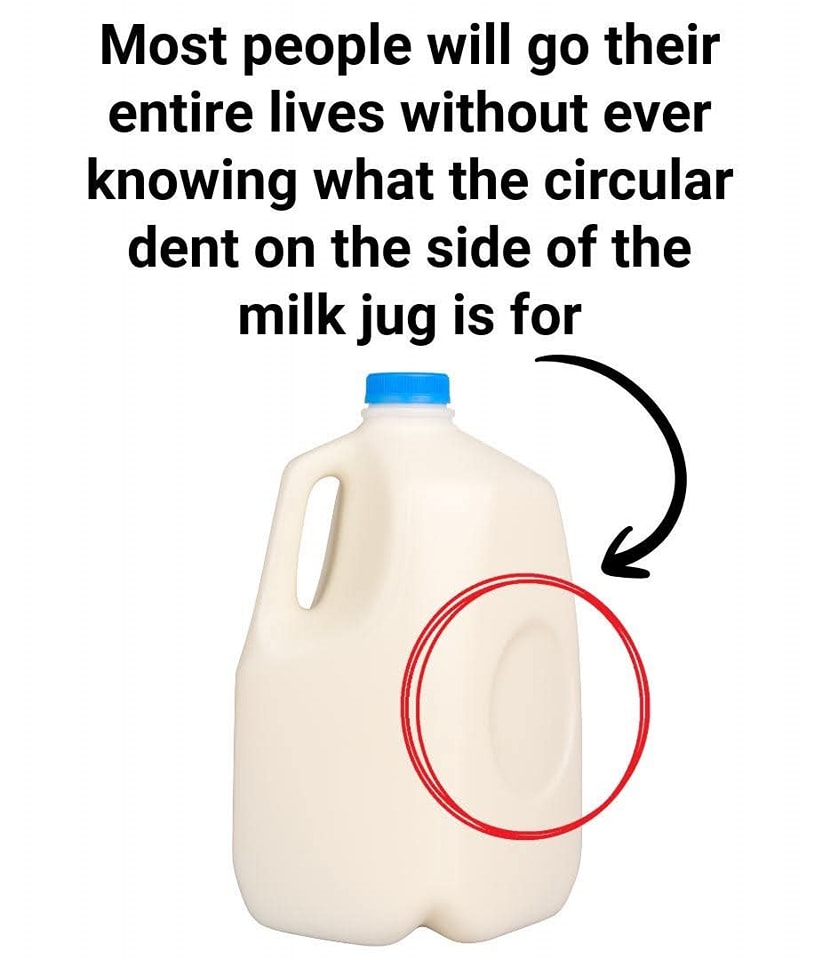I’ll be the first to admit it—I’ve stared at that strange little dent on the side of a milk jug more times than I can count. You know the one. It’s perfectly round, slightly sunken in, like it’s hiding a secret. And, surprisingly, it is. If you’re like most people, you probably assumed it was just part of the plastic molding process or maybe even something decorative. But as it turns out, that circular dent serves a very real and surprisingly clever purpose.

So, go ahead and pour yourself some milk, and let’s break down the mystery behind the milk jug dent. That small circle isn’t a flaw or an afterthought—it’s a key component of the jug’s structural design. It’s there for a blend of safety, practicality, and durability. First off, it acts as a buffer for expansion due to temperature-related pressure changes. Milk, being a perishable liquid, needs to be stored cold. And like most liquids, it expands and contracts with temperature fluctuations. So, when milk goes from the warmth of a delivery truck to the chill of your refrigerator—or even a freezer—the volume inside the jug can change. Without some way to accommodate this shift, the plastic container might expand outward, crack, or worse, burst.
That’s where the dent comes in. It allows the jug to flex just enough to absorb the pressure changes, acting like a little built-in stress relief zone that helps prevent messy milk disasters. But that’s not all. The dent also works as a shock absorber. Think about how many times a jug of milk is dropped or jostled—whether in the back of a shopping cart, during transport to the store, or when you accidentally knock it over while reaching for the ketchup. That recessed circle helps dissipate impact energy, reducing the likelihood of cracks or breaks. Anyone who’s ever had to mop up a milk spill knows how important that can be. For grocery stores and manufacturers, it means fewer damaged products, fewer spills, and less waste—real savings that add up.
Another bonus of this clever design is that it helps the jug retain its shape without using extra plastic. Much like the ridges in cardboard boxes or arched ceilings in architecture, the dent adds structural strength. Instead of thickening the jug walls, which would make it heavier and more expensive to produce, the dent gives the container the support it needs while staying lightweight. It’s a smart engineering solution that keeps production costs and material use down.
And here’s an unexpected twist—sometimes that little dent can even act as a spoilage indicator. If the milk inside starts to go bad and bacteria begin to grow, they release gas, which builds up pressure inside the jug. In some cases, that pressure causes the dent to puff out. So, if you ever pick up a milk jug and notice the dent has popped outward, it might be your milk’s way of waving a little red flag. Of course, not every bulge means spoilage, but it’s still a useful heads-up that something might be off. Now you may be wondering: why a circle? Why not a square or a triangle? Well, circles are naturally strong shapes that distribute pressure evenly. Unlike corners, which can concentrate stress and weaken over time, a circular shape spreads that force out smoothly. That makes it ideal for handling both physical shocks and internal pressure changes. Plus, from a manufacturing standpoint, circles are easier to mold and replicate with consistency, especially when you’re producing millions of identical jugs. While we’re on the topic of jug design, here are a few other cool details you may not have noticed. The handle isn’t just for easy gripping—it also reduces the amount of plastic used without sacrificing functionality. The small bumps at the base help the jug stay balanced on uneven shelves. And depending on the region or brand, the cap color can indicate fat content—like red for whole milk or blue for 2 percent. It’s kind of amazing how much thoughtful design goes into something as ordinary as a milk jug. Speaking of thoughtful, let’s not forget the environmental benefits. Thanks to the dent, less plastic is needed to make each jug, which reduces waste and makes recycling easier. Lighter jugs also mean lower transportation costs and fuel savings, making them more eco-friendly overall. So next time you reach for that gallon of milk, give a little respect to the unassuming dent that’s doing a whole lot behind the scenes. It keeps your milk fresher, your kitchen cleaner, and the planet just a little bit greener—all without asking for any credit. It might not win you a trivia trophy, but if conversation ever stalls, just drop the fun fact: “Did you know the dent in a milk jug can actually warn you if the milk’s going bad?” You’ll be the most interesting person in the room. You’re welcome.





